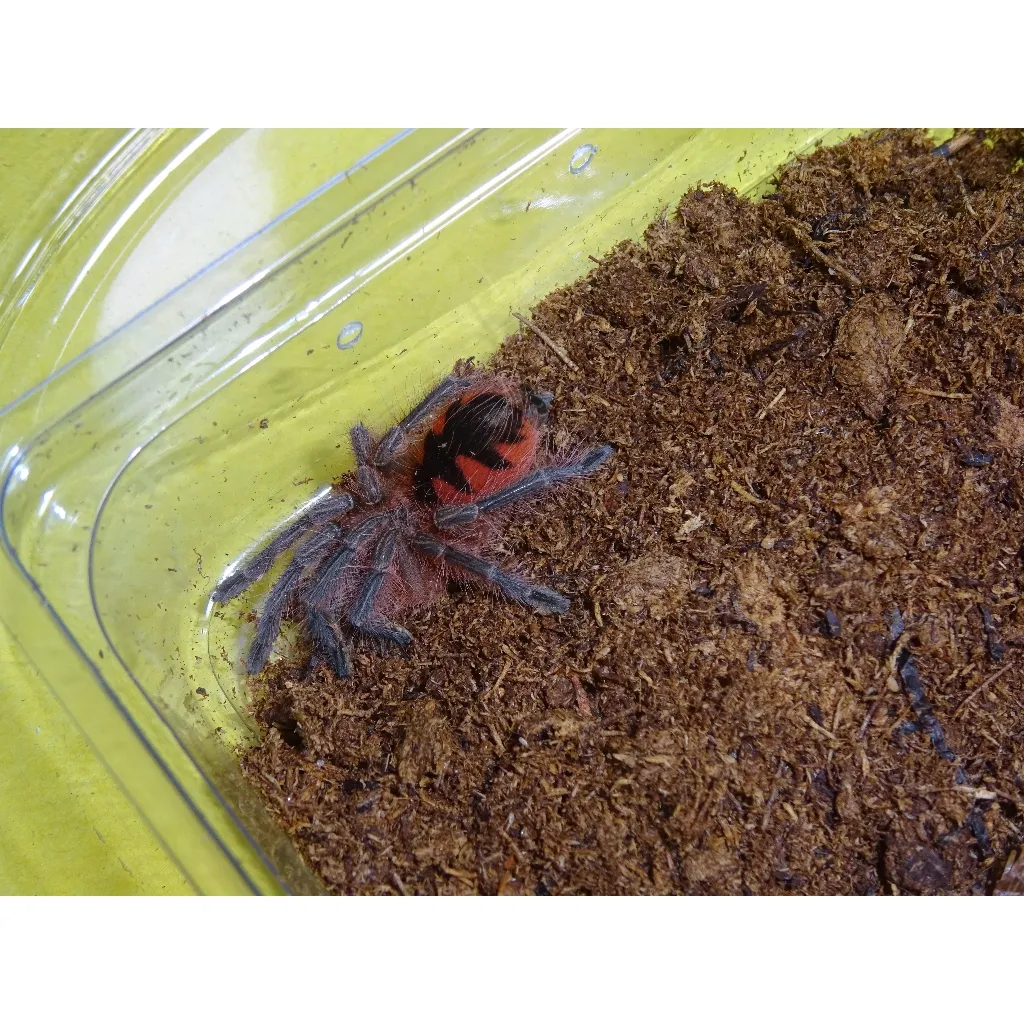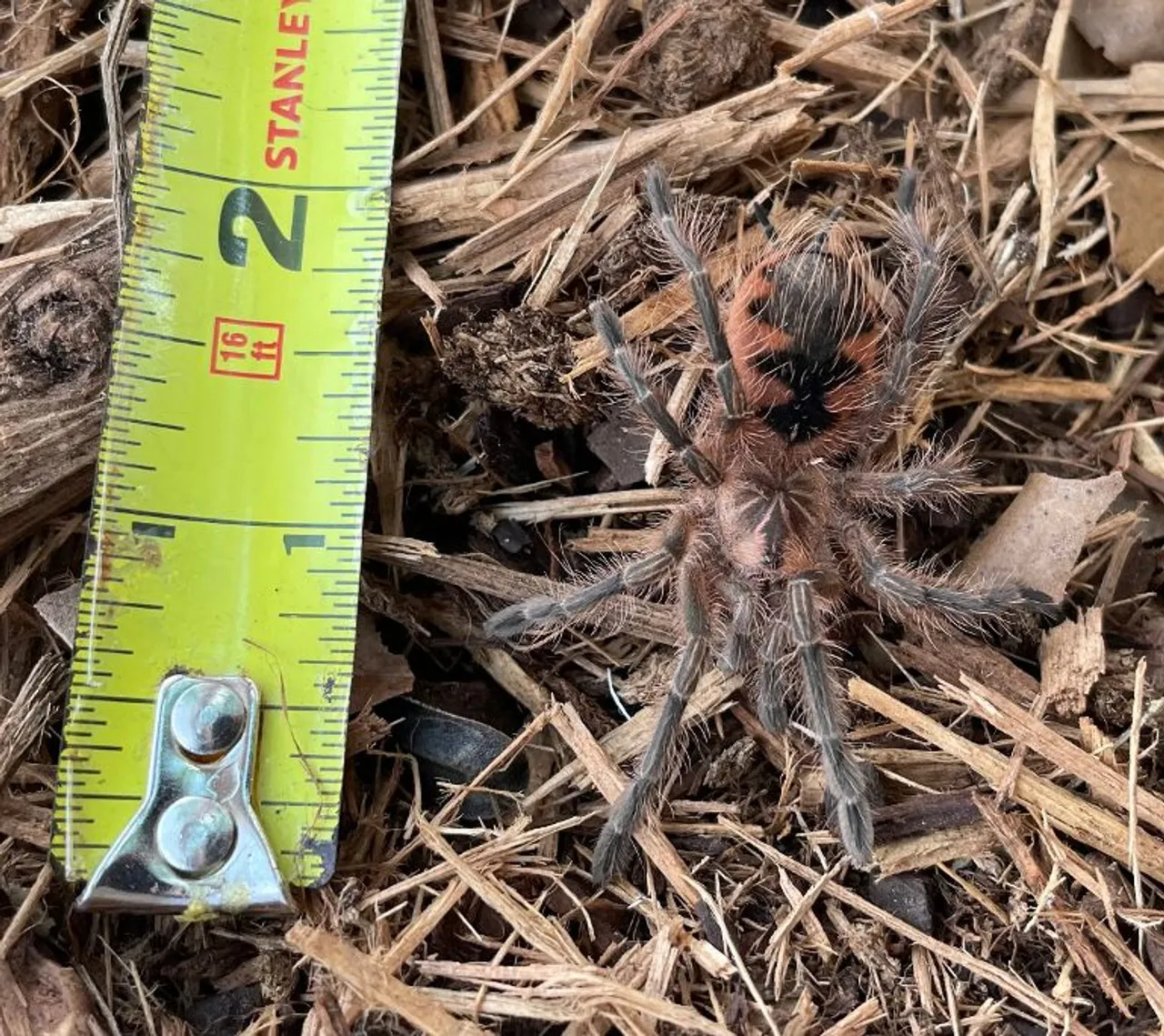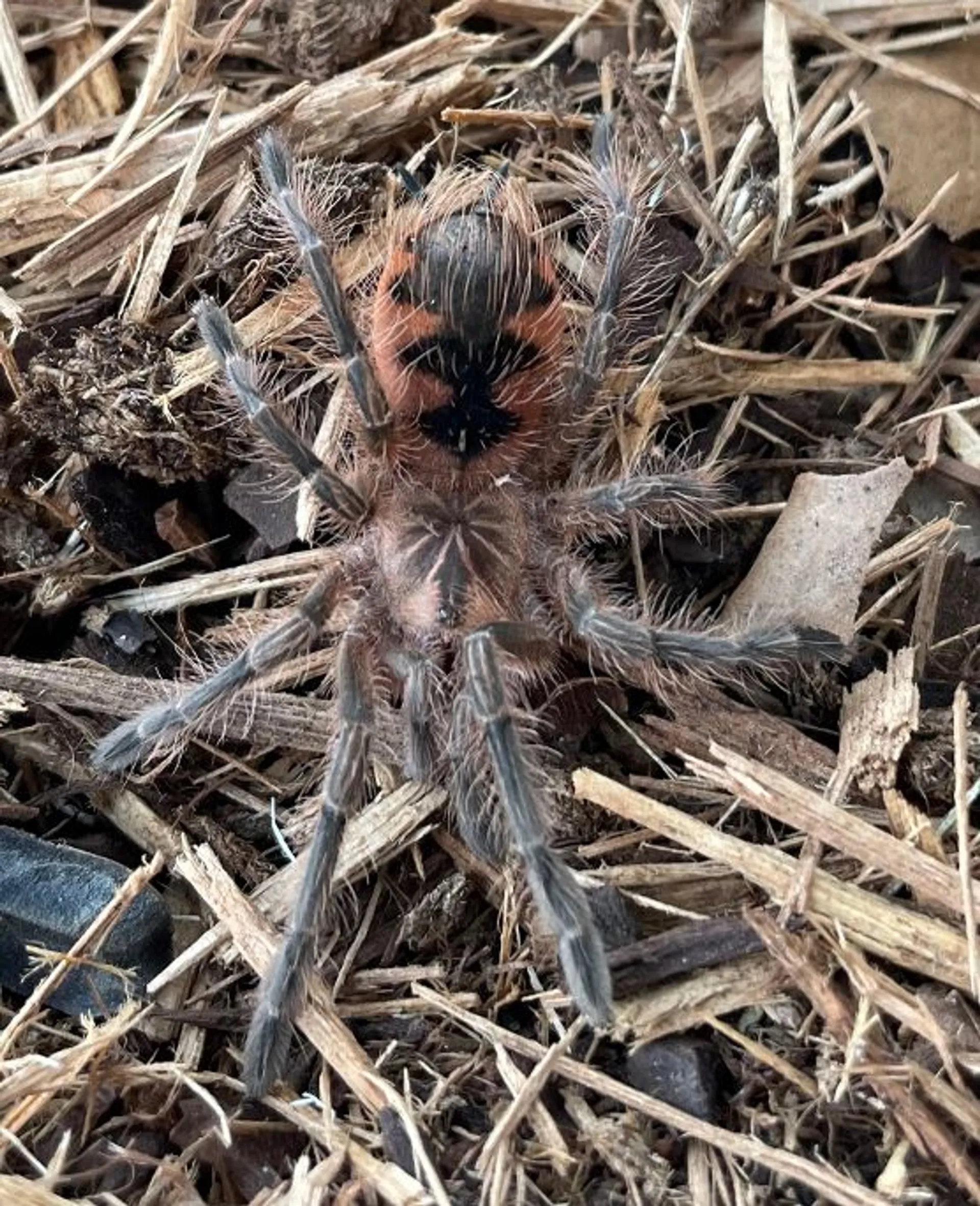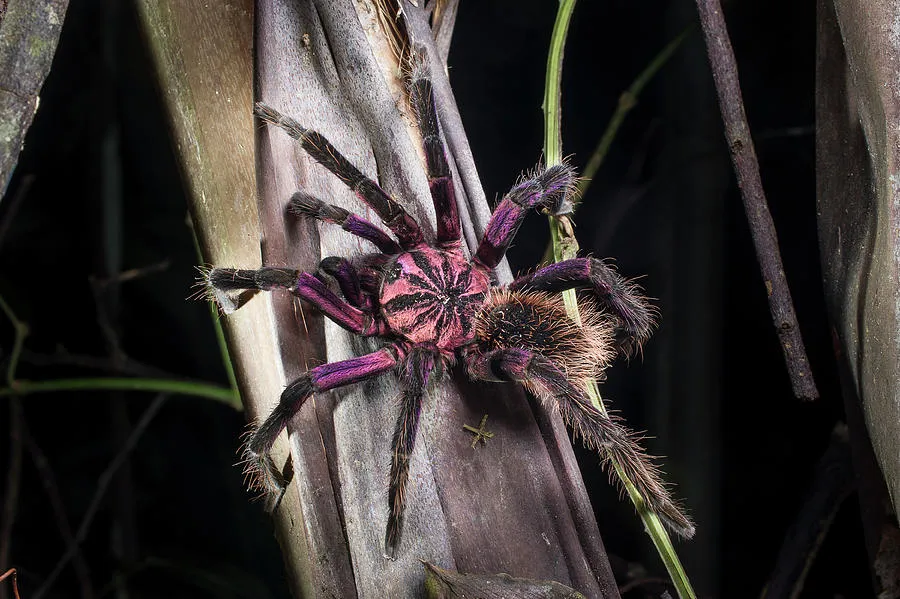What is a Colombian Purple Tarantula?
The Colombian Purple Tarantula (Xenesthis intermedia) is a captivating species, renowned for its striking coloration and relatively docile temperament, making it a popular choice among tarantula enthusiasts. Native to the tropical rainforests of Colombia, this New World tarantula is a terrestrial species, meaning it spends most of its time on the ground. Their beauty and manageable size contribute to their appeal, but potential owners should always be prepared to provide proper care to ensure a long and healthy life for their pet. These spiders are not only aesthetically pleasing but also offer a fascinating glimpse into the world of arachnids, making them a rewarding pet for those willing to learn about their specific needs and behaviors.
Appearance and Characteristics
Colombian Purple Tarantulas are known for their vibrant coloration. They possess a striking purple hue that intensifies as they mature. This color, coupled with their size and overall appearance, makes them visually stunning creatures. The overall morphology of the species, typical of tarantulas, includes eight legs, two pedipalps used for sensory functions, and chelicerae containing fangs. Their bodies are covered in urticating hairs, which they can flick off as a defense mechanism. Understanding these characteristics is essential for providing appropriate care and handling the tarantula safely.
Coloration and Size

The rich purple coloration is a defining characteristic, ranging in shade from a deep violet to a more reddish-purple, which can vary slightly depending on individual tarantulas and their stage of life. The females tend to be larger than the males, with a leg span that can reach up to 7-8 inches. Males are typically smaller and often have a more slender appearance. The size of the tarantula, combined with its striking colors, makes it a visually impressive pet, easily captivating the attention of anyone observing it.
Habitat and Origin
These tarantulas originate from the rainforests of Colombia, where they thrive in humid environments. They are terrestrial spiders, spending most of their time on the ground, creating burrows or seeking shelter under rocks and logs. In their natural habitat, they are ambush predators, waiting for unsuspecting prey to come within range. Mimicking this environment in captivity is crucial for their well-being. This means providing a suitable substrate that allows for burrowing, maintaining the right temperature and humidity levels, and offering appropriate hiding places.
Where to Buy Colombian Purple Tarantulas?
Finding a Colombian Purple Tarantula for sale involves researching reputable sources. The internet offers a wealth of options, from specialized breeders to online pet stores. Local pet stores may also carry them, but availability can vary. The key is to choose a seller who prioritizes the health and well-being of the tarantulas, offering healthy specimens and providing accurate information about their care. Always check reviews, ask questions about the tarantula’s origin and age, and ensure the seller is knowledgeable and willing to assist with any questions.
Reputable Breeders

Reputable breeders are a cornerstone when buying a tarantula. They prioritize the health of their spiders, often offering guarantees and providing valuable advice. They typically have a good understanding of the species and its specific requirements. They are transparent about the tarantulas’ lineage and health history. Finding a breeder with a positive reputation can significantly improve your chances of getting a healthy, well-adjusted tarantula. Look for breeders who are passionate about tarantulas and are always willing to answer your questions thoroughly.
Online vs. Local Pet Stores
Both online retailers and local pet stores have their pros and cons. Online stores often have a wider selection and competitive pricing. However, you can’t physically see the tarantula before purchasing it. Local pet stores allow you to examine the spider and speak with staff. However, the selection might be limited, and the staff’s knowledge may vary. Whichever option you choose, always verify the seller’s reputation and ensure they prioritize the well-being of the tarantulas they sell.
What to Consider Before Buying
Before purchasing a Colombian Purple Tarantula, consider the following: your experience level, the financial commitment (including the cost of the tarantula, enclosure, and ongoing supplies), and your long-term commitment to providing proper care. Research the specific needs of this species, including its ideal habitat, feeding requirements, and health considerations. Ensure you have adequate space and a suitable environment prepared before bringing the tarantula home. This proactive approach will contribute to the well-being of the tarantula and will allow you to enjoy your pet responsibly.
Proper Enclosure Setup

A well-designed enclosure is crucial for the Colombian Purple Tarantula’s health and happiness. The setup should replicate the tarantula’s natural habitat as closely as possible, providing security and opportunities for natural behaviors. This section covers essential aspects of the setup, ensuring a safe and stimulating environment.
Choosing the Right Tank
The enclosure should be appropriately sized for the tarantula’s current and expected adult size. A glass or acrylic terrarium with a secure lid is recommended. The enclosure should be escape-proof and offer enough space for the tarantula to move around, burrow, and feel secure. Avoid overly large enclosures for smaller tarantulas, as they may feel vulnerable. A good rule of thumb is to provide a tank that is at least three times the tarantula’s leg span in length and width, and twice its leg span in height.
Substrate and Decor
The substrate should be several inches deep to allow for burrowing. A mixture of coconut fiber, peat moss, and vermiculite is ideal, as it holds moisture well and allows the tarantula to create its burrow. Decorate the enclosure with cork bark, artificial plants, and other hiding places to provide security and enrichment. Avoid using sharp or rough materials that could injure the tarantula. The decor should mimic the tarantula’s natural environment, offering visual stimulation and hiding spots to minimize stress.
Temperature and Humidity

Maintaining the correct temperature and humidity levels is vital. The ideal temperature range is between 75-85°F (24-29°C). Use a heat mat or ceramic heat emitter attached to a thermostat to regulate the temperature. Humidity levels should be around 70-80%, which can be achieved by misting the enclosure regularly and ensuring the substrate remains slightly damp. Use a hygrometer to monitor the humidity level. Proper ventilation is essential to prevent mold and maintain air quality within the enclosure.
Feeding and Care
Proper feeding and care are fundamental to the tarantula’s health. This includes offering the appropriate food, establishing a regular feeding schedule, and ensuring access to clean water. Regular observation of the tarantula’s behavior and appearance will help you identify any potential problems.
Types of Food
Colombian Purple Tarantulas are carnivores and primarily feed on insects. Suitable food items include crickets, mealworms, dubia roaches, and other commercially available insects. Vary the diet to provide a balanced nutritional intake. Ensure the insects are gut-loaded with nutritious food before feeding them to your tarantula. Avoid feeding wild-caught insects, as they may carry parasites or pesticides. The size of the food should be appropriate for the tarantula’s size; generally, the prey should be no larger than the tarantula’s body.
Feeding Schedule

The feeding schedule should be tailored to the tarantula’s age and size. Spiderlings should be fed more frequently, usually every other day. Adult tarantulas can be fed less frequently, typically once or twice a week. Remove any uneaten food within 24 hours to prevent the growth of mold and bacteria. Observe your tarantula’s feeding habits; a tarantula that refuses food may be about to molt or experiencing stress. Adjust the feeding schedule accordingly based on your tarantula’s behavior and condition.
Watering and Hydration
Provide a shallow water dish with fresh, clean water at all times. Replace the water frequently to prevent contamination. Some tarantulas may prefer to drink from droplets on the side of the enclosure, so misting the enclosure regularly can also help with hydration. Ensure the water dish is easily accessible and doesn’t pose a drowning hazard. Clean the water dish regularly to prevent the buildup of algae and bacteria, which could be harmful to the tarantula.
Health and Common Issues
Like all pets, Colombian Purple Tarantulas can experience health problems. Being aware of common issues and knowing how to identify potential problems is crucial for the well-being of your tarantula. This section will discuss shedding, molting, and common diseases and parasites.
Shedding and Molting

Molting is a natural process where the tarantula sheds its exoskeleton to grow. During this time, the tarantula may stop eating and hide. Provide a humid environment and avoid disturbing the tarantula during molting. After molting, the tarantula will be vulnerable and its fangs will be soft for a few days. Avoid feeding the tarantula until its fangs have hardened. Observe the tarantula’s behavior and appearance to ensure the molting process goes smoothly. After molting, the tarantula’s colors may appear brighter.
Parasites and Diseases
While relatively hardy, tarantulas can be susceptible to parasites and diseases. Common problems include mites, fungal infections, and bacterial infections. Mites can be introduced through substrate or food, and they can irritate the tarantula. Treat any issues promptly by consulting with a veterinarian experienced in exotic animals. Prevention includes maintaining a clean enclosure, proper humidity and temperature, and quarantining new tarantulas. Regular observation of your tarantula’s health is paramount to early detection.
Handling and Safety
While Colombian Purple Tarantulas are generally not aggressive, handling them carries certain risks. Knowing how to handle them safely and responsibly is essential. Always prioritize the well-being of the tarantula and understand its defensive behaviors.
Safe Handling Practices

Handling should be kept to a minimum, and only attempted when necessary, such as for enclosure maintenance. Always approach the tarantula calmly and avoid sudden movements. If you must handle your tarantula, gently coax it onto your hand, supporting its body. Never force the tarantula to move or make sudden grabs. Always handle the tarantula over a soft surface, like a bed or couch, in case it falls. After handling, always wash your hands thoroughly.
Tarantula Bites and Venom
While the venom of a Colombian Purple Tarantula is not considered medically significant to humans, a bite can still be painful and cause localized swelling and discomfort. Avoid handling the tarantula if you are unsure or uncomfortable. If bitten, clean the area with soap and water and monitor for any signs of infection. The tarantula’s urticating hairs can cause irritation if they come into contact with your skin or eyes. Be aware of this defensive mechanism and avoid exposing yourself to these hairs whenever possible. Be prepared for any potential reaction, and consult a doctor if you have concerns.
